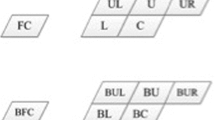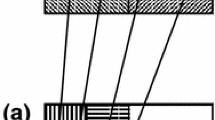Abstract
Traditional rate-distortion (R-D) model-based Lagrange multiplier \(\lambda \) that is employed by H.264/SVC does not consider the inter-layer correlation. This paper presents new R-D models and \(\lambda \) which exploits inter-layer correlation for coding modes that perform residual prediction in H.264/SVC medium-grain quality scalability (MGS) coding. We have observed that in MGS coding, the prediction error of modes performing residual prediction is approximately equal to the reconstruction error of the corresponding macroblock in the reference layer. Based on that observation, we investigate the distribution \(f_r \) of transformed residual prediction error signals and prove that \(f_r \)is related to the quantization step of the corresponding macroblock in the reference layer. In such a case, both the conventional \(\lambda \) and the R-D models in the literature that are derived independently of inter layers are not much fit for residual prediction modes any more. Thus, we build more appropriate R-D models depending on the derived distribution and develop a new \(\lambda \) from the R-D models. Experimental results show that when residual prediction is enabled, the proposed scheme by using the new Lagrange multiplier achieves an average PSNR gain of 0.47 dB and up to more than 1 dB over the scheme using the conventional Lagrange multiplier.





Similar content being viewed by others
References
Advanced video coding for generic audiovisual services. ITU-T Recommendation H.264 and ISO/IEC 14496–10 AVC. Joint Video Team, (2010)
Li, W.: Overview of Fine Granularity Scalability in MPEG-4 Video Standard. IEEE Transactions on Circuits and Systems for Video Technology 11(3), 301–317 (2001)
Schwarz, H., Marpe, D., Wiegand, T.: Overview of the Scalable Video Coding Extension of the H.264/AVC Standard. IEEE Transactions on Circuits and Systems for Video Technology 17, 1103–1120 (2007)
Wiegand, T., Girod, B.: Lagrange Multiplier Selection in Hybrid Video Coder Control. Proc. IEEE International Conference on Image Processing 3, 542–545 (2001)
Schwarz, H., Wiegand, T.: R-D Optimized Multi-layer Encoder Control for SVC. Proc. 2007 IEEE International Conference on Image Processing 2, 281–284 (2007)
Li, X., Amon, P., Hutter, A., Kaup, A.: Lagrange Multiplier Selection for Rate-Distortion Optimization in SVC. Proc. 2007 Picture Coding, Symposium, pp. 1–4. (2009)
Li, X., Oertel, N., Hutter, A., Kaup, A.: Laplace Distribution Based Lagrange Rate Distortion Optimization for Hybrid Video Coding. IEEE Transactions on Circuits and Systems for video technology 19, 193–205 (2009)
Lam, E.Y., Goodman, J.W.: A Mathematical Analysis of the DCT Coefficient Distributions for Images. IEEE Transactions on Image Processing 9, 1661–1666 (2000)
Gish, H., Pierce, J.: Asymptotically Efficient Quantizing. IEEE Transactions on Information Theory 14, 676–683 (1968)
Reichel J. Joint Scalable Video Model 11 (JSVM 11). Joint Video Team, doc. JVT-X202, Geneva, (2007)
Bjontegaard, G.: Calculation of Average PSNR Differences Between RD-curves. 13th VCEG-M33 Meeting, (2001)
Lin, H.C., Peng, W.H., Huang, H.M.: Fast context-adaptive mode decision algorithm for scalable video coding with combined coarse-grain quality scalability (CGS) and temporal scalability. IEEE Trans. Circuits Syst. Video Technol. 20, 732–748 (2010)
Author information
Authors and Affiliations
Corresponding author
Appendix
Appendix
1.1 Appendix A: Derivation of equation (18)
According to domain of n,
With the definition of \({P}_{n} \) in (16),
1.2 Appendix B: Derivation of Equation (21)
With (15), Eq. (20) can be rewritten as:
where
and
Putting (30) and (31) into (29), we can get the distortion model defined in (21).
Rights and permissions
About this article
Cite this article
Zhao, L., Zhou, Y., Wu, F. et al. Inter-layer correlation considered R-D models and Lagrange multiplier for SVC MGS coding. SIViP 8, 1581–1589 (2014). https://doi.org/10.1007/s11760-012-0409-y
Received:
Revised:
Accepted:
Published:
Issue Date:
DOI: https://doi.org/10.1007/s11760-012-0409-y




